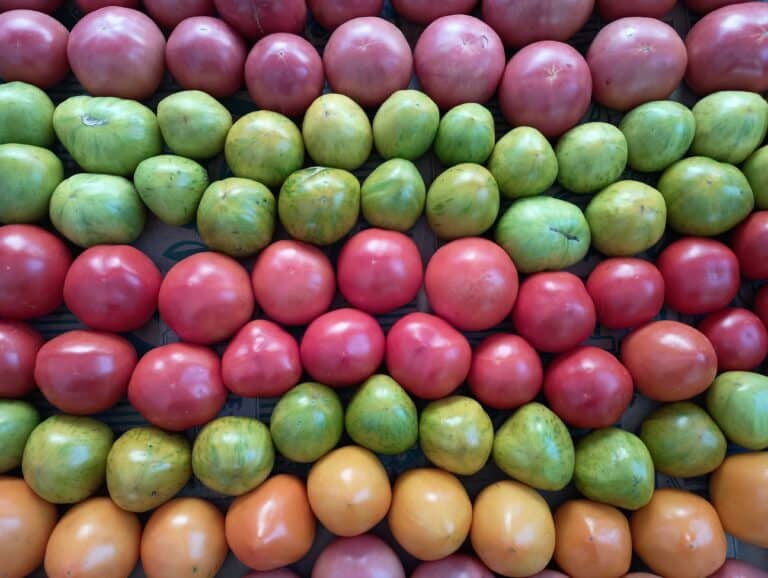
We have certainly enjoyed a few cool mornings amid these ever-humid dog days of summer. The first signs of fall trigger warm-loving plant hormones into the deliberate process of shutting down for good, or prepare them for hibernation. The early plantings of tomatoes, zucchini, cucumbers, and the like are shutting down. Later plantings of these kinds of crops are still to come until frost.
Combined with the linear decline in day length, the spring garden is waning, so we are busily preparing and planting the fall garden, with the intention of getting us through the winter and until next year’s spring garden kicks in. After all, with six months of frost-free growing conditions here on the banks of the Elkhorn, that leaves six months of eating fresh wholesome foods to attend to.
In order to eat high on the hog all winter we have been nurturing several varieties of Irish and Peruvian potatoes, sweet potato, and hard squash all summer, and garlic since last fall. The potatoes were cut up and planted in May, and the sweet potatoes slipped in mid-June, so now we are just starting to see the fruits of our labor. Early harvest looks good coming in. The packing shed morphs through several configurations of cleaning and sorting, curing some and refrigerating others, ahead of long term storage of each crop as they come in. Patience is a virtue when it comes to harvesting root crops.
As we till under the spring plantings, late summer is the beginning of the time to sow seeds like spinach and lettuce and kale for harvest this winter. We started seeding, and setting transplants for the fall second growing season earlier in August, and intend to be seeding and sowing more of the same with the hopes of having fresh greens all winter. The trick is these cool season loving plants have to get birthed into an unhospitable hot environment in order to mature before winters wrath takes its toll. So, some of these crops will be covered with the gauzy fabric which gains us 5 or 6 degrees of frost/freeze protection, which usually buys us a couple of more months of crops to harvest. Other transplants are scheduled to go into one of the high tunnels for harvest in the dead of winter.
The thing is, Mother Nature never shows her cards. As the days shorten, the plants need more days to collect enough solar energy to reach maturity, and if it is cloudy much, add a few more days on top of that. Another obvious player in this 3D chess match we call farming is the unsteady decline in average air temperature with cold snaps thrown in for good measure. Some years our Labor Day plantings complete their entire life cycle, and some years they barely mature before winter shuts them down. We think our game plan, with various season extension strategies and multiple plantings of various varieties of each crop, will afford us the opportunity to harvest fresh vegetables all winter. We will find out over time which ones will make it, and which will not, but we plan for all extremes.
We are well outside farming cultural norms, growing and harvesting vegetables all winter. Not too long ago, back about the turn of the century, we closed up shop a couple of weeks after first frost and waited for spring to go back into the fields! In the spring season, farmers know to get their peas and spinach sowed the first chance they get in spring, plant potatoes on Good Friday, and summer stuff goes out Derby weekend. Sure, there is some gambling on late frost to worry about, but by and by, the days get longer and warmer with fairly predictable growing conditions ahead. For our second season, we have a few years of trial and error under our belts, and our friends at the UK Sustainable Agriculture Farm on the Southern edge of Lexington have developed some recommendations, but each second season has been a little different, so patterns are just coming into view.
The row covers, sometimes referred to as frost blankets, are a big help, but also a big pain in the…well, a lot of work. Some crops we can allow the covers to float over the top of the crop, but a good frost will damage the leaves that are actually touching and holding up the cover. To alleviate this problem, we must deploy wire hoops to hold the blanket above the crop, but hey, it doesn’t take that long to set a few thousand hoops if it increases the yield later on. Then there is the issue of weeds growing under there, which means the covers must get periodically laid back, the crop chopped out, and the covers replaced. We only need several thousand home-made sand bags the size of a big grapefruit to place along the edges to keep the wind from sending the cover sailing away. (There is one tree that was adorned several years ago with a 100 foot piece, and some remnants will be visible again when the leaves drop in November).
In fall and winter, we will watch the weather forecast closely to time the harvest of these protected plants. When leaves freeze overnight, we must wait for them to thaw to handle. Plus, the sandbags freeze to the ground, making it impossible to pull the covers back. And to be clear, it is often muddy and wet and cold while doing all this. We are glad to go to all this effort in our quest to provide sustenance to good people who appreciate good food, all year long.
– Mac Stone



Made with 
